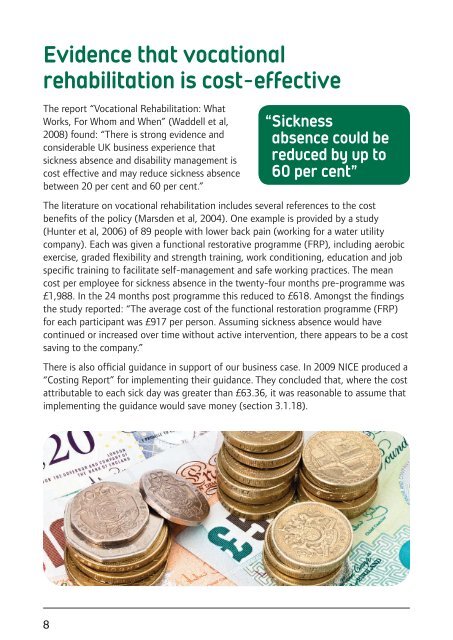Vocational rehabilitation The business case for retaining newly disabled staff and those with a long-term health condition
Vocational rehabilitation The business case for retaining newly disabled staff and those with a long-term health condition
Vocational rehabilitation The business case for retaining newly disabled staff and those with a long-term health condition
You also want an ePaper? Increase the reach of your titles
YUMPU automatically turns print PDFs into web optimized ePapers that Google loves.
Evidence that vocational<br />
<strong>rehabilitation</strong> is cost-effective<br />
<strong>The</strong> report “<strong>Vocational</strong> Rehabilitation: What<br />
Works, For Whom <strong>and</strong> When” (Waddell et al,<br />
2008) found: “<strong>The</strong>re is strong evidence <strong>and</strong><br />
considerable UK <strong>business</strong> experience that<br />
sickness absence <strong>and</strong> disability management is<br />
cost effective <strong>and</strong> may reduce sickness absence<br />
between 20 per cent <strong>and</strong> 60 per cent.”<br />
“Sickness<br />
absence could be<br />
reduced by up to<br />
60 per cent”<br />
<strong>The</strong> literature on vocational <strong>rehabilitation</strong> includes several references to the cost<br />
benefits of the policy (Marsden et al, 2004). One example is provided by a study<br />
(Hunter et al, 2006) of 89 people <strong>with</strong> lower back pain (working <strong>for</strong> a water utility<br />
company). Each was given a functional restorative programme (FRP), including aerobic<br />
exercise, graded flexibility <strong>and</strong> strength training, work <strong>condition</strong>ing, education <strong>and</strong> job<br />
specific training to facilitate self-management <strong>and</strong> safe working practices. <strong>The</strong> mean<br />
cost per employee <strong>for</strong> sickness absence in the twenty-four months pre-programme was<br />
£1,988. In the 24 months post programme this reduced to £618. Amongst the findings<br />
the study reported: “<strong>The</strong> average cost of the functional restoration programme (FRP)<br />
<strong>for</strong> each participant was £917 per person. Assuming sickness absence would have<br />
continued or increased over time <strong>with</strong>out active intervention, there appears to be a cost<br />
saving to the company.”<br />
<strong>The</strong>re is also official guidance in support of our <strong>business</strong> <strong>case</strong>. In 2009 NICE produced a<br />
“Costing Report” <strong>for</strong> implementing their guidance. <strong>The</strong>y concluded that, where the cost<br />
attributable to each sick day was greater than £63.36, it was reasonable to assume that<br />
implementing the guidance would save money (section 3.1.18).<br />
8


